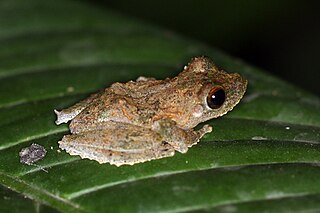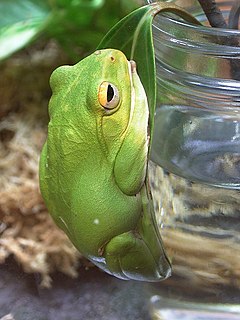
The leopard tree frog is a species of frog in the family Hylidae endemic to Brazil. Its natural habitats are subtropical or tropical dry forests, subtropical or tropical moist lowland forests, subtropical or tropical moist montane forests, freshwater marshes, intermittent freshwater marshes, plantations, rural gardens, heavily degraded former forests, ponds, and canals and ditches.
Hyperolius pardalis is a species of frog in the family Hyperoliidae. It is found in Cameroon, Central African Republic, Republic of the Congo, Equatorial Guinea, Gabon, and possibly Democratic Republic of the Congo. Its natural habitats are subtropical or tropical moist lowland forests, rivers, swamps, freshwater marshes, intermittent freshwater marshes, rural gardens, heavily degraded former forest, and ponds.

The painted chorus frog is a species of frog in the family Microhylidae. It is found in northeast India, Myanmar, southern China, Hong Kong, Taiwan, Thailand, Cambodia, Laos, Vietnam, Peninsular Malaysia, and Singapore. Its natural habitats are subtropical or tropical moist lowland forest, subtropical or tropical moist montane forest, subtropical or tropical moist shrubland, swamps, intermittent freshwater marshes, arable land, plantations, rural gardens, ponds, open excavations, and irrigated land. It is not considered threatened by the IUCN.

Limnonectes khasianus, commonly known as the corrugated frog, rivulet frog, or sometimes (ambiguously) called "flat-headed frog", is a species of frog in the family Dicroglossidae. It is found in Brunei, India, Indonesia, Malaysia, Myanmar, Thailand, and possibly Bangladesh and Bhutan. Its natural habitats are subtropical or tropical moist lowland forest, subtropical or tropical moist montane forest, rivers, intermittent rivers, freshwater marshes, and intermittent freshwater marshes. It is not considered threatened by the IUCN.
Zhangixalus chenfui, also known as Chinese whipping frog or Chenfu's treefrog, is a species of frog in the family Rhacophoridae endemic to China where it is found in Sichuan, Guizhou, Hubei, and Fujian provinces. Its natural habitats are temperate forests, subtropical moist lowland forests, subtropical moist montane forests, subtropical moist shrubland, freshwater marshes, rural gardens, ponds, and irrigated land. It is not considered a threatened species by the IUCN.
Zhangixalus dorsoviridis, also known as the green-back treefrog, is a species of frog in the family Rhacophoridae that is found in northern Vietnam and southern China (Yunnan). It may be confused with Rhacophorus nigropunctatus. Its natural habitats are subtropical or tropical moist montane forests, freshwater marshes, and intermittent freshwater marshes. It is threatened by habitat loss.

Polypedates leucomystax is a species in the shrub frog family Rhacophoridae. It is known under numerous common names, including common tree frog, four-lined tree frog, golden tree frog or striped tree frog. Many past authors have united it with the common Indian tree frog in P. maculatus, but today they are generally considered distinct species. In its native range, it is also called "white-lipped tree frog", but this name is otherwise applied to a species of true tree frogs.
Rhacophorus nigropunctatus is a species of frog in the family Rhacophoridae. It is found in China, possibly Myanmar, and possibly Vietnam.

The frilled tree frog, rough-armed tree frog, or Southeast Asian tree frog is a species of frog in the family Rhacophoridae found in Brunei, Cambodia, India, Indonesia, Malaysia, Myanmar, the Philippines, Thailand, and Vietnam. Its natural habitats are subtropical or tropical moist lowland forest, subtropical or tropical swamps, subtropical or tropical moist shrubland, rivers, swamps, freshwater marshes, and intermittent freshwater marshes. It is threatened by habitat loss.
Rhacophorus barisani is a species of frog in the family Rhacophoridae endemic to Indonesia. Its natural habitats are subtropical or tropical moist montane forests, rivers, and freshwater marshes. It is threatened by habitat loss.
Leptomantis bimaculatus is a species of frog in the moss frog family (Rhacophoridae). Described by Wilhelm Peters in 1867, it is endemic to the Philippines. There, it is known to occur on the islands of Bohol, Mindanao, and in the south of Luzon; it might also be found on other islands as its known range brackets the main chain of the Philippines archipelago.

The blue-spotted tree frog is a species of frog in the family Rhacophoridae. It is found in Indonesia, Malaysia, Singapore, Thailand, and Vietnam, and possibly Brunei and Myanmar. Its natural habitats are subtropical or tropical moist lowland forests, subtropical or tropical moist montane forests, and rivers. It is threatened by habitat loss.

The Chinese flying frog or Chinese gliding frog is a species of tree frog in the family Rhacophoridae found in China, Laos, Burma, and Vietnam. It is also known as Blanford's whipping frog, large treefrog, and Denny's whipping frog.
Leptomantis fasciatus is a species of frog in the family Rhacophoridae found in Indonesia and Malaysia. Its natural habitats are subtropical or tropical moist lowland forests and intermittent freshwater marshes. It is threatened by habitat loss.

Feihyla kajau is a species of frog in the family Rhacophoridae found in Indonesia and Malaysia. Its natural habitats are subtropical or tropical moist lowland forests, rivers, freshwater marshes, and intermittent freshwater marshes. It is threatened by habitat loss.
Rhacophorus orlovi is a species of frog in the family Rhacophoridae. The species is endemic to Southeast Asia.

Zhangixalus owstoni or Owston's green tree frog is a species of frog in the family Rhacophoridae endemic to Japan. Its natural habitats are subtropical or tropical moist lowland forests, subtropical or tropical seasonally wet or flooded lowland grassland, intermittent freshwater marshes, and irrigated land. It is threatened by habitat loss. The population is currently stable.
The Malayan flying frog is a species of frog in the moss frog family (Rhacophoridae). It is found in Indonesia, Malaysia, and Thailand.

Rhacophorus reinwardtii is a species of frog in the family Rhacophoridae. It is variously known under the common names of black-webbed treefrog, green flying frog, Reinwardt's flying frog, or Reinwardt's treefrog. It is not considered threatened by the IUCN.
Robinson's tree frog is a species of frog in the family Rhacophoridae found in Malaysia and Thailand. Its natural habitats are subtropical or tropical moist lowland forests and intermittent freshwater marshes. It is threatened by habitat loss.











